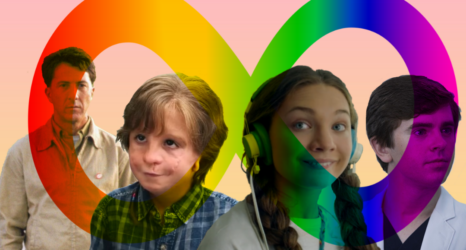
The number of U.S. women and girls receiving an autism diagnosis is on the rise—and in April, the autism rate for girls surpassed 1 percent, the highest ever recorded in the country. These rocketing rates in autism diagnoses do not indicate a general increase in autism overall, but rather an increase in knowledge and awareness of the condition, especially for girls and women.
Autism can take many forms and often presents differently depending on a person’s gender, race, class and more. Yet, for decades, portrayals of autism in media relied on sexist (and racist) tropes and stereotypes—think: nerdy, “awkward” white men who love science, like Sam Gardner from Atypical or Raymond Babbitt from Rain Man—which are unrepresentative of the actual experiences and identities of people with autism.
Sexist biases of autism have also played out in the medical field: Doctors and medical providers without enough examples of autism have often failed to recognize it in patients that didn’t fit the societal stereotypes about who experiences autism, and how.
As a result, women and girls on the spectrum have been more under- or misdiagnosed with autism than boys, and on average receive diagnoses later in life than boys and men do.
- At age 18, 80 percent of autistic women remained undiagnosed, according to research from Robert McCrossin from 2022.
- In 2022, the ratio of autistic boys and men, to autistic girls and women, was 4:3, according to National Library of Medicine estimates. But as recently as 2017, this number was assumed to be 4:1.
One reason for the underdiagnosis of women with autism is because they are more likely to hide the markers of autism that may lead to diagnoses—which is called masking. Though it can present differently depending upon race, gender and socioeconomic status, masking generally entails mimicking the behavior and interaction styles of neurotypical (non-autistic) people. This painful process involves concealing an autistic person’s natural self—and traits of their autism—to protect themselves from an ableist world. Studies on autistic adults have found that women mask their autism more than men do, which may explain why they often fly under the radar. The cause may relate to sexist social expectations for women and discrimination from patriarchal medical systems.
Girls are also more likely to monitor whether they fit in and consequently adjust their behaviors. “Because of the way women are socialized to ‘fit in’ and pick up on social cues, underlying traits of autism … essentially get missed,” wrote autistic author Dr. Jenara Nerenberg in her book Divergent Mind (2020).
Under- or misdiagnoses are also suspected to be prevalent among trans and gender-diverse individuals. People from this group also struggle with gender-specific issues, such as the problem of passing, as well as the struggle of gender dysphoria, which affects how their masking presents and their experience of discrimination. Delayed diagnoses are also prevalent among Black, Latinx and Asian children, and people in poverty.
It’s hard unlearning a lifetime of being taught to blend in.
Sexism Built Into Diagnostic Tests
Sexist misconceptions about autism also stem from the development of autism diagnostic tests. When creating these tests, scientists primarily based their design on biases favoring boys, especially white, economically privileged ones. These biases connect back to Nazi-era psychiatrist Hans Asperger, who used racist, inhumane practices aligned with Nazism to treat autism, such as race-hygiene policies like forced sterilizations and the child euthanasia program.
Along with racist biases, autism diagnostic tests have carried sexist biases into the present. Doctors may screen for restricted interests, a common autistic trait. They often stereotype this as a boy who fixates on a few topics, like trains, taxis, maps or U.S. presidents. This sexist stereotype can inhibit doctors from recognizing autism in girls, who can have different fixations that might fit stereotypically “feminine” interests, like animals, dolls, unicorns or celebrities. This means for girls, the intensity of their fixation can indicate autism perhaps more than the object of interest itself.
Masking can also put pressure on autistic people to change their body language. Alex, a 22-year-old trans nonbinary person diagnosed with autism at 20, described masking as “an unconscious survival strategy”—for example, a behavior necessary to succeed in jobs. They use the example of maintaining eye contact, which they often find challenging. “I make good eye contact, and I shake the interviewer’s hand,” said Alex. “If I was unmasked in that situation, I might seem ‘unprofessional’ and therefore might not be chosen for the position.”
Eliza, a 24-year-old woman diagnosed with autism in elementary school, also mentioned eye contact as difficult to maintain and described her choice to make eye contact as part of her masking. “I definitely try to look people in the eyes more. I have to work hard to do that, but even one of my therapists thought I didn’t have autism because I looked her in the face the whole time.” She said, “I just mask [my autism] because it’s what society wants us to do, and that thing is to stare people in the face.”
Because of the way women are socialized to ‘fit in’ and pick up on social cues, underlying traits of autism … essentially get missed.
Dr. Jenara Nerenberg
Another facet of ableism is the term “high-functioning”—which is often used to describe someone with less-visible autism. Alex considered the term a label “based on how much of a nuisance to others an autistic person is.” Instead, they prefer the term “high-masking.”
The pressure they feel to conform to neurotypical standards can be a trauma response and can cause distressing mental health consequences, like autistic burnout and conditions like depression or anxiety. Autistic girls and women are also more vulnerable to sexual exploitation and abusive relationships, rooted in the desire to feel accepted and avoid being ostracized. Masking has also been linked to “lifetime suicidality.”
Empowering Girls on the Spectrum
The pressure to mask can severely affect the overall health of women and girls. However, some powerful tools exist to help overcome these challenges.
Connecting with other people in autistic communities can help autistic girls and women unfold in this challenging process of self-acceptance. Finding activist groups run by autistic people and for autistic people, like the Autistic Self Advocacy Network (ASAN) and its affiliates, such as the Autistic Women & Nonbinary Network (AWN) and Autistic Self Advocacy Network (ASAN), can help unite them with other members in similar situations.
Organizations to avoid include those like Autism Speaks, a problematic organization on many levels, with only one autistic person out of the 28 individuals on its board of directors, most of whom represent major corporations. Autism Speaks also supports Applied Behavior Analysis (ABA), a form of therapy that dissuades autistic students from doing harmless neurodivergent behaviors like hand-flapping—using in past years punishments as abusive as electrocution—and rewards them for conforming to non-autistic behaviors, which can make them deeply uncomfortable.
Instead of defining themselves by what they lack, autistic girls and women can try identifying themselves more by their strengths. In her book, Nerenberg emphasizes the value of heightened empathy innate in many autistic people and how such empathy can nurture compassionate environments among coworkers, families and friends. They can also celebrate other traits that often come with autism, such as their creativity, focus and attention to detail, and authenticity.
We should also center autistic voices when working on behalf of the anti-ableist movement. “It’s only when [people] reach out to the autistic community that they begin to build an accurate understanding of autism by learning from the lived experiences of actually autistic people,” wrote Sharon DaVanport, autistic activist and founding executive director of AWN.
Uplifting autistic women and girls is no simple task; it will take a vast community effort. But together, we can fight to replace sexism and ableism with mutual acceptance, respect and love, creating a world where neurodiverse people not only can survive, but thrive.
Up next:
U.S. democracy is at a dangerous inflection point—from the demise of abortion rights, to a lack of pay equity and parental leave, to skyrocketing maternal mortality, and attacks on trans health. Left unchecked, these crises will lead to wider gaps in political participation and representation. For 50 years, Ms. has been forging feminist journalism—reporting, rebelling and truth-telling from the front-lines, championing the Equal Rights Amendment, and centering the stories of those most impacted. With all that’s at stake for equality, we are redoubling our commitment for the next 50 years. In turn, we need your help, Support Ms. today with a donation—any amount that is meaningful to you. For as little as $5 each month, you’ll receive the print magazine along with our e-newsletters, action alerts, and invitations to Ms. Studios events and podcasts. We are grateful for your loyalty and ferocity.





